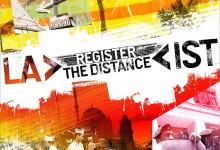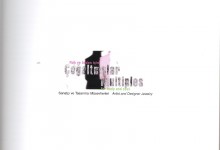AKDENİZ METAFORLARI II
Contemporary Art from LEBANON
4 February-11 March 2000
Nelly Chemaly, Marwan Rechmaoui, Walid Raad, Walid Sadek, Jihad Touma Mohamad Soueid, Mahmoud Hojeij, Rania Stephan, Akram Zaatari, Walid Raad, Rita Awn
After Cairo, it was essential to visit the next legendary Mediterranean city: Beirut.
During my five day visit to Beirut, I was hosted by Christine Tohme, who tirelessly took me to the artists’ studios all around the city, driving through the brand new avenues and dangerously narrow streets. Within the traditional and modern urban texture, the most striking aspect of the city was the absence and the abundance reflected respectively in the gothic looking façades of the ruined apartments and villas and on the mirrored fronts of the high-tech skyscrapers. Among them, an extremely hollow-eyed and spooky looking yellow “konak”-like building which stood off by itself on a large street corner, caught my eye. Later, I heard Rita Awn talking about this once exquisite building. She has visited it several times, looking for traces of a past life, reviving her own memories of life before the civil war, and documenting whatever was possible.
All of the other artists I visited, Walid Sadek, Walid Raad, Marwan Rechmaoui, Nelly Chemaly, Jihad Touma, and most of the video-films I had the opportunity to see during the past year, had an insistent and enduring approach to the problem of re-thinking and re-constructing the past. This seemed to be the common attitude. Putting aside questions on the nature of this pursuit, such as “is it nostalgia?”, I listened to the description of past and recent works and future projects. The works mainly by-passed the outdated modernist ways of categorizing the past and the present local-world. The artists were aware of two things: The bizarre chapters of the history of the Middle East should be investigated painstakingly and in detail, in order to challenge the limitations of any world view that was constructed in the 20th century Middle East, and an earnest critique should be made of the polluted and disordered thinking. This attitude has a constructive trajectory. Even more so when we recognize that most of these artists, having lived and worked abroad before and during the war, willingly came back to Beirut to have a hand in re-building. Secondly, the city was intensively present in their works. It became a perfect metaphor for their common and private histories. We all know that history in our region continuosly flows towards us and beyond us and we hang in space between this perplexing transition; sometimes we run away from it, but at the same time, addicted to this perplexity, we always come back to our cities. It is not that they had a wish to return to those days, even if they can no longer find the solidarity, attachment and devotion they had during the long days and nights in their shelters. They want to convey that their attitude to the past is a very critical one, that they want to get a grip on the past. They know that through their knowledge and experience they can find and display infinitely many perspectives toward a contingent paradigm of a future city.
When compared to their contemporaries in the Western centers, there is a certain difference in their attitudes. The new artists in the West (Western or Non-Western) claim that art and the everyday (the trivial) are collaborating in re-defining the commodity culture. They believe that they are not afraid of playing by the rules of the commodity. There is not only a certain philistinism in attitudes, but also in the mega-exhibitions that are being designed in relation to this kind of art. It has to be said, that most of these artists come from working class and middle class background; evidently they pay their tribute. This seems not to be the case in Beirut. The artists mostly come from the upper-middle class; they are well-educated, intellectually emgaged and committed. Their works represent a radical configuration of the context and have a critique which is rather in the domain of conjectural reference. Even if they penetrate into the deepest levels of the everyday life, the forms and values of the art works don’t favorably interfuse with the popular culture of the street, which is extremely influenced by “wild” capitalism. The artists obviously utilize the strategies of critical post-modernism. I think they know very well that the outcome of their detailed preparation and their strategy to transform in the hope of promoting social changes is ultimately immeasurable. As in Istanbul, art in Beirut is still the performance/activity of a handfull and not a total culturalisation, as in New York, London or Berlin, where “change through art” has become purely utopian. There is still a certain promise of social change in the air and the artists can still have an effect, especially when they invite the people to consider the spatial and social interdependence of the private and the public, of the state and the citizen. It seems very likely that in Lebanon as well as in Turkey, artists will contribute to the making of a civil society of the 21st century.
Akdeniz Metaforları dizisinin ilk sergisinde Mısır çağdaş sanat ortamından üç sanatçının Mona Marzouk, Mohamed Fathi Abo El Naga ve Rehab El Sadek’in yapıtları sunulmuştu. İkinci sergi, 20.yy’ın ikinci yarısındaki yazgısına bakıldığında, Doğu Akdeniz’in en dramatik kenti olan Beyrut’dan bir çağdaş sanat kesitini sundu. Çok yönlü ve karmaşık bir savaşı geride bırakan Lübnan’ın yalnız bu acılar ve anılar dolu geçmişini değil, yeniden yaşama dönüşünü ve bölgenin enerji dolu bir ülkesi olmaya doğru yol alışını izlemek ilginç. Bu aşamaları sanatçıların yorumlarında izlemenin yararlarına değinmek gerekir. Birincisi, çevresine duyarlı kişilerin, çapraşık işlemlerden geçmiş ve kaynağından kopmuş bilgi yerine, bireysel gücünü koruyabilen ve kendi bağımsız politikasını sürdürebilen sanatçının, salt kaynağa ulaşma amacıyla oluşturduğu bilgiye gereksinimi vardır. İkincisi ise, bugün artık kullanılması olanaksız olan geçmiş bakış açılarından kurtulmanın yolunu sanat yapıtlarında incelemenin yararıdır. İngiltere’de yaşayan Şamlı yazar Rana Kabbani’nin sözlerinde, sürmekte olan bu, eski görüşten yeni görüşe geçiş süreci en yetkin bir biçimde açıklanır. Kabbani, Avrupa’nın Doğu İmajı adlı kitabında “Bu konu etrafında çalışırken, sömürgeci kalıtın inatçılığından kurtulabilmiş bir Doğu-Batı diyaloğuna ulaşabilmek için yeniden bir gözden geçirme ve miras alınan pek çok yaklaşımı reddetme yolunda gerçekten ciddi çabaların zorunlu olduğunu duyumsadım. Bu miras alınmış yaklaşımlar öylesine ısrarlı, öylesine yıkıcı ki, dürtülerimizi gölgeliyor, onların ötesindeki insanlığı görmemizi engelliyor.” diyor.(1)
Borusan Sanat Galerisi’nin Akdeniz Metaforları sergi dizisi, gündemdeki- geçmişe göre farklı- Doğu Batı diyaloğunda, Akdeniz boyutunu sanat yapıtında değerlendirmek gibi önemli bir işlevi sürdürmeyi amaçlıyordu.
Bu sergide Istanbul sanat ortamı, aralarında özellikle video/film alanında uluslararası üne sahip sanatçıların da bulunduğu Lübnan’lı 10 sanatçıyı çok gereçli yerleştirmeler ve video-filmlerle tanıma olanağı buldu.
Nelly Chemaly, Marwan Rechmaoui, Walid Raad, Walid Sadek ve Jihad Touma’nın karışık teknikteki yerleştirmeleri sergi salonunda yer alırken, Mohamad Soueid, Mahmoud Hojeij, Rania Stephan, Akram Zaatari, Walid Raad ve Rita Awn’ın videoları da etkinlik salonunda gösterildi.
Yapıtlar, genel olarak geçmiş ve bugün arasındaki ilişkileri/ilişkisizlikleri, geleneklerin savaş sırasında ve sonrasındaki durumlarını irdeliyor, savaştan sonra yitirilen değerlerin yerini nelerin aldığını gösteriyordu. Bu yerleştirmelerde ağırlıklı olarak fotografik ve dijital imgeler kullanılmıştı.
20.yy sanatının “Modernizm” döneminde Akdeniz kültürlerinin özellikleri, Kübizm (1910’lar), Sürrealizm (1920’ler), Yeni Gerçekçilik (1960’lar), Arte Povera (1970’ler), Transavanguardia (1980’ler) gibi belli başlı akımlara damgasını vurmuştur. 1980’lere kadar, bu akımların ortaya çıktığı Fransa ve İtalya Akdeniz kimliğinin temsilcileri gibi görünüyordu, 1980’lerde Yunanistan ve İspanya bu gruba katıldı. Yüzyıl boyunca, Akdeniz kimliğinin tarihsel mirasını taşıyan Afrika ve Orta Doğu ülkeleri, siyasal, ekonomik ve toplumsal bunalımlar ve çıkmazlar yüzünden geri planda kaldılar. Modernizm bu ülkeleri bir yandan bu yüzyılın uygarlık düzeyine çıkarırken, bir yandan sert toplumsal ve kültürel kopuşlara neden oldu; sanatçılar da yüzyıl boyunca bu ülkelerin sanatçılarının toplumları için “yeni bir sanat” üretmeye çalıştı. Kimliklerin ve davranışların öne çıkması, kültürel kökenlerin ve çeşitliliğin değer kazanması, geleneksel ve güncelin uzlaşması gibi gereklilikleri doğuran Postmodernizm ve sonrası gelişmeler, bu ülkelerdeki çağdaş sanatın, dünya sanat sahnesinde yerini almasına neden oldu. Akdeniz’li sanatçının kimliği ile post-modernist yaklaşımlar arasındaki koşutluk, Akdeniz’deki çağdaş sanat üretiminin bundan böyle daha çok ilgi çekeceğine kesinlik kazandırıyor.
Sergi, Borusan Sanat Galerisi Sanat Danışmanı Beral Madra’nın Beyrut sanat ortamı ile yaklaşık bir yıldır sürdürdüğü ilişki sonucunda gerçekleşmiştir. Beyrut’lu genç sergi yapımcısı Christine Tohme’nin bu ilişkinin somut sonuca dönüşmesine büyük katkısı olmuştur.



